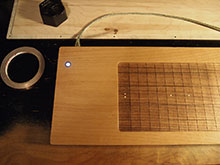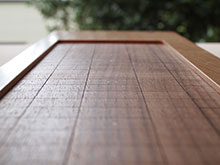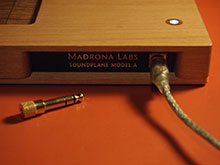randy's Recent Posts
Did you find the manual?
More good ideas. Doing a good UI for the configuration would take a while, but I could do the folder thing pretty quickly, and that seems very useful.
Of course I'm working hard on getting the Soundplane into production. But meanwhile, people are doing great stuff with Aalto!
Mark Mosher sent this video of Aalto, controlled with the Percussa AudioCubes. It really shows off Aalto's drone capability with a super Forbidden-Planet-style patch.
SoundsDivine just released the Chaos Ripple patch bank for Aalto. More info here: [soundsdivine.com] Some of these patches make timbres come out of my synth that I haven't heard before. And they represent a wide range of sounds. Great job!
Finally, I'd like to point out the ongoing and interesting stuff coming out of the Aalto Soundcloud page. It turned into a really thriving group where there's great new stuff almost daily, from simple sound examples to finished tracks. People are getting their modular funk on. Here's the most recent entry:
are you or are you not somehow related to Android Samba Girl. by jumpy gunderson
Thanks for this! I will definitely be adding some automation features with 1.3. I need to gather all the ideas and look at what set of them makes sense to do.
I forgot to mention, the VST version does not have this problem!
Hmmm, I hear you. What if I could map a MIDI command to next patch / previous patch? Would that be enough?
The thing is, I don't have a concept of "banks," so if I tried to allow random access into the entire list of patches, saved automation would get screwed up if you added more patches in between. But with next / previous you could automate a show.
Hi, welcome aboard!
This has been a known bug for too long. Unfortunately it has been very hard to fix. Thanks for your patience.
Added checking this out to the 1.3 list -- thanks.
I just got back from a whirlwind trip to NYC to show the Soundplane at the Expo74 event put on by Cycling '74. I got to meet a few of the first ever Soundplane owners in person (hi guys) and to see lots of old friends from the Max/MSP world.
Soundplane got to meet Monome and Arc for the first time! Awwwww:
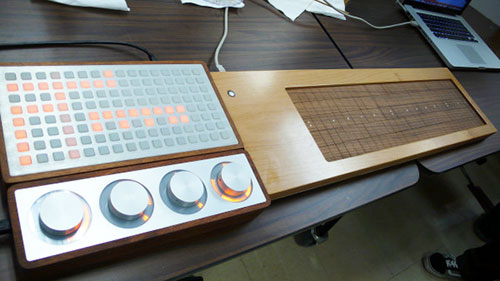
Just a little news for current and future Soundplane buyers. 14 Soundplanes have been reserved, so 16 remain out of the first batch of 30. Preorders keep coming in one by one, so I am hopeful that after my trip down the coast, I will have sold out the initial batch. By then, we will also have quotes from our suppliers, so we may be able to go ahead with production in any case if we are within arm's reach of 30.
I'm setting up a payment system that will work for future preorders as well as European customers. Mostly this means waiting for banks and such at the moment. So, EU customers especially, stay tuned.
Well, this was a big week for Soundplane! Lots of people came by to find out about them and play with one. I'm very happy to share this video of some of the results.
We will be taking preorders very soon. Stay tuned for the official announcement on how to go about getting a Soundplane Monday morning. Sorry for the slight delay on this, but I have some details to work out and I want to enjoy some more of the great music at Decibel this weekend.
You can solve any problem like this with unit cancellation.
you have: (beats / minute)
you want: Hz (beats / second)
(beats / minute) * (1 minute / 60 seconds) = (beats / second)
In other words divide by 60.
There are two default directories. In English these are called (your home directory) / UserData for your presets and C: / AppData / Roaming for factory presets. So, for user presets I would look for some directory like "C:/...(home)/UserData" but in Portuguese.
Or, you could search your disk for some of the user presets like "Alessandro's Machines".
Our new system is a controller, so I don't know what you mean.
Breaking news! I know that while the Soundplane looks fun, and sensitive, it might take touching one in person to know if you want to make music with it. So I'm going to be doing lots of traveling in the next few weeks, to bring a Soundplane prototype within reach of as many people as I can...
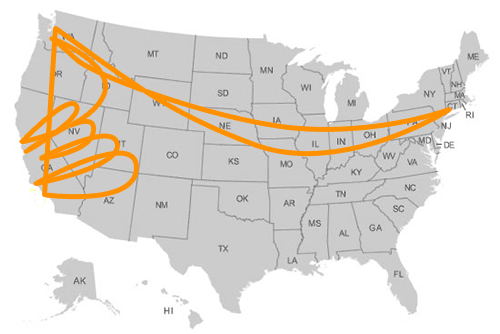
The first stop will be Expo '74, hosted by Cycling 74 in Brooklyn, New York this weekend! I will be showing the Soundplane, connected to Max/MSP through a brand new soundplane~ object, at the Expo '74 science fair on Saturday evening. I know this is incredibly last-minute news, but this only came together thanks to last-minute events and the flexibility of my generous hosts.
Registration for the Expo is closed. But don't fear. I wouldn't come all that way and not do a demo that other people can come to. I'm going to find some time during the weekend to set up camp at a local cafe, hacker space or even a private abode. I'm still looking for a good place. If you will be in NYC and do want to come, or want to suggest a place (I'm staying at a friend's in Brooklyn) please get in touch via the forums here. If it's only a handful of people, maybe we can do it at a private studio or residence.
Remember that my Twitter feed is the best place to get truly late-breaking news. I'll be posting there for certain once I know more.
So, on to the less last-minute stuff: the West Coast tour. As announced on Create Digital Music, here are the upcoming dates I'll be demoing Soundplane in the Golden State:
Robotspeak, San Francisco, Saturday Nov 5, 4pm
CNMAT, U C Berkeley, Monday Nov 7, 2pm
UCSB, Media Arts and Technology Seminar, Tue Nov 8, 5:30 pm
CalArts, Thur Nov 10, 6:30pm
All of these events are free and open to the public. Come play with a Soundplane, and ask questions about anything from capacitive sensing to CNC machining to software! I look forward to meeting you.
Hi Matt,
I wasn't being clear, I meant "between two Aalto patches."
So... this should work. I will have to try it out in Audiomulch to see what's happening. Will do this for the next release. Aalto development is a little slow due to Soundplane work-- I hope you understand.
-Randy
@x2mirko:
MIDI use with other synthesizers as Brian describes is possible, but the Soundplane and Aalto for Soundplane connect over OSC. Aalto for Soundplane has a new input section based on OSC that sends signals into the patcher for each note.
The Soundplane itself doesn't use MIDI! You could hook your MIDI interface to the Soundplane client software to output MIDI from your Mac.
I simply didn't want to promise anything before I knew I could do it. I'm going to talk to some other manufacturers and figure this out ASAP though.
@eerohyy
Yes, Aalto + Numerology = great!
The demo works fine too.
@induction,
Thanks for your interest-- I will figure out the customs issues ASAP. Hopefully within the month.
I'm not sure how you would morph between two Aalto plugins, because the patcher is always either on or off for a given cord. And the cords do not automate, which may be part of the problem. I will look into this for 1.3.
AU or VST?
Hi,
Not sure about the reverb changing-- if so, not on purpose.
I use magic mouse all the time too. The trick is to find a balance between controllers like magic mouse that put out many many mousewheel 'clicks,' and other mice that just put out one per click. Unfortunately (and this hurts me too) I had to decide that the other mice were much more common. I will look at this more in the future.
I understand. That would be a good feature and I will find a way to add it. It's the broken keyboard handling in some hosts that makes it a pain.
If you have a host like Logic that offers a "generic view", you can view the plugin parameters including modulation amounts in that view, and copy/paste values.
I never had the chance to try Audiomulch, hopefully someone else can help.
There's not really a direct comparison. Aalto's OSC sounds to me more like the 259 than the 259e. But, Aalto has limitations that the hardware doesn't have. And Aalto's filter is a model of an SEM, because I love that sound.
The client app will be open-source C++. So you can talk to it over OSC, or just hack your own client if you want.
Here are a few pictures I took today to make a product onesheet. This is one of two playing surfaces we have made prototypes of. It's a walnut veneer on a fiber / elastomer backing. The other surface is a thicker walnut that acts more like articulated keys. We'll have both kinds of surface on hand to compare at the demo, starting tomorrow.
@guss
Good insight and question. It's nice to play on top of the edges, especially.
The "proud" surface posed some bigger engineering challenges and will also be more expensive to make. the recessed surface is working great now, and has been refined through lots of testing.
So recessed is the default, and there will probably be an option to get the Soundplane with a thicker surface soon.
I definitely thought about this issue. What I've done is put the USB jack through an aluminum backplate that's much thicker than an ordinary sheet metal case -- 1/8 in. the jack is very tightly fit into the plate so that the wobbling that normally breaks the solder joints over time is minimized.
